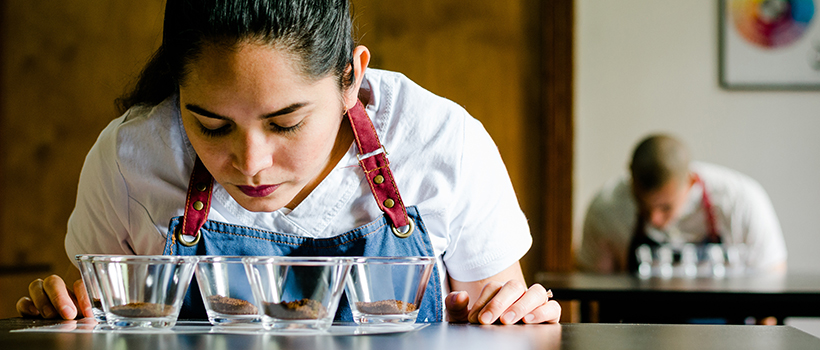
Q&A: investigating off flavours and taints
21 September 2023 | Susan Rogers, Sensory Insights Section Manager and Rob Levermore, Flavour and Taint Group Manager
Flavour is an important component of food quality. Understanding flavour, off flavours and taints – including their formation and how they change during processing and storage – is vital when it comes to product quality, product development, in process control and for troubleshooting.
Problems with taints and off–flavours can cost food and drink companies considerable money and time through wasted product, impact on reputation and lost production. Taint is a sensory issue, but often needs chemical analysis to determine what it is and how it arose. Understanding the cause is crucial in preventing recurrences.
Where a product has a taint, we offer a range of sensory and instrumental techniques to help identify the cause and can also advise on how to prevent reoccurrence. Here we share some questions and answers from Susan Rogers (Sensory Insights Section Manager) and Rob Levermore, (Flavour and Taint Group Manager) to share some of their knowledge and an overview of the support that they and their teams can provide to you in this area.
1. What are off flavours and taints? What’s the difference between them?
A taint is an unpleasant odour or flavour that is foreign to the food / beverage product. They may be detected through routine quality checks, or from customer complaints.
Off flavours are generally defined as unpleasant odours or tastes due to natural deterioration of the food. Taints, on the other hand, are usually regarded as unpleasant odours or tastes resulting from contamination of a food by one or more extraneous chemicals.
Typical taint descriptions include, for example, 'antiseptic', 'musty', 'rancid' and 'petrol'. A manufacturer may have noticed the taint themselves or have received consumer complaints, but not know the cause. Sometimes the problem turns out to be microbiological in origin. An odour of 'nail varnish remover' or 'pear drops', for example, can arise from wild yeast contamination of baked goods.
2. How do taints arise?
Taint can arise from many sources during production, transportation and storage. A few examples of causes of taint include inadequately cleaned vats, tainted wooden pallets, exposure to cleaning fluids, dirty bottles, or proximity to odorous substances. It can also be due to batch variation, microbial activity and deterioration of foods during storage, with rancidity being the most commonly encountered example of this last possibility.
We find that taint issues come in two main types:
- the first is when the client knows that there is a problem - for example, they, their customer or a consumer, have detected the taint, and want to know what it is and how it might have arisen
- the second is when they think they may have a problem or where they want to assess the potential for a problem
As a very general rule of thumb, the former will rely on chemical analysis and the latter on sensory analysis.
3. How can Campden BRI help?
Our expert sensory assessors can conduct sensory assessments on suspect tainted samples, and compare this against their assessment of a control sample.
Through this, our expert panel of highly trained sensory assessors can objectively describe and quantify the intensity of the attributes perceived of the offending flavour (as well as taints in odour or aftertaste). Off flavours tend to be specific for a particular product, whereas taint compounds are common across product categories.
As well as our highly trained descriptive panel, we also have a panel of expert sensory assessors who specialise in characterising beers and other alcoholic beverages, and in particular identifying the typical off flavours and taints associated with these products and indicating their potential sources / causes.
4. Do you use only sensory testing?
Based on results of the tasting / sensory assessments, we can recommend appropriate analytical tests that can measure the comparative levels of particular flavour compounds between a complaint sample / tainted product and control sample of the same product.
Where a particular flavour cannot be determined to be responsible for the taint, then we can use other analytical instruments (such as gas chromatography-mass spectrometry, GC-MS) to screen the samples and identify the differences between the tainted and control samples. Using GC-MS allows us to detect and identify tainting compounds without needing to know what they are beforehand.
We can also compare the overall volatile profiles of samples using principal component analysis. This is a statistical technique used on multivariate data sets to display any significant variations between the samples, which due to the huge amount of data involved would not be apparent from visual examination of the raw results. This latter technique could be used for taint investigations but is more commonly used for flavour analyses of acceptable samples, for example to examine the similarities and differences between different brands of the same product type or different varieties of the same fruit or vegetable, or to assess the effects of differing product treatment or manufacturing techniques on foods.
5. How can you test for taints through sensory assessment?
An objective description of the sensory characteristics of a taint can be very important in tracing its source. Consider how that sample is being prepared, presented and assessed by the panel.
When testing for taint, there are two main sensory tests that we use – these are free description testing and triangle testing.
Free description test –
This testing is conducted by our descriptive panel of expert sensory assessors. The assessment is descriptive, whereby the assessors use their own objective sensory terminology to describe the odour, flavour and aftertaste of the control sample, followed by the test sample. Samples are presented blind (3-digit codes), and the panel record their description of the attributes perceived and the intensity associated with these descriptors.
Triangle test –
The triangle test is applied when you wish to determine whether there are sensory differences between two samples, typically a control and test sample (suspect tainted). The principles of the triangle test involve presentation of three samples to a panel of trained sensory assessors – two samples are the same, and one is different. Assessors are asked to identify which of the samples is different to the other two and to describe the difference(s) perceived.

6. Once you have determined and confirmed the presence of an off flavour or taint, what more can be done?
Once we have identified the nature of an off flavour / taint through sensory assessment and confirmed it through analytical data, we can support in determining the source of the taint. For example, through our expert knowledge of raw materials and processes, we can assist in determining at which point in the supply chain / manufacturing process the cause of the problem may have occurred.
To support such investigations, we can help to trace back and evaluate raw materials and in-process / intermediate samples.
7. How about preventative measures?
We can assess client’s products for the potential to taint, such as via packaging materials, flooring compounds, cleaning chemicals (disinfectants or sanitisers) and skincare (sanitisers, soaps and protection hand creams). We can also advise on measures to take to prevent tainting from occurring in your products.
We are here to help
Across our business, we have more than 200 scientists and technical experts collaborating on a wide range of projects every day.
Our sensory panels and sensory team have the experience and technical insights that link product sensory characteristics with sensory outcomes. Our assessment services range from simple quality checks right through to full, descriptive sensory mapping / profiling of your products in comparison to others.
We can characterise the sensory attributes of your product, to guide product development, shelf-life testing and extension, quality control, and taint troubleshooting and prevention. Where a product has a taint, we offer a range of sensory and instrumental techniques to help identify the cause.
So, whether you are dealing with a taint challenge in an existing product or are developing something new, get in touch for the support of our sensory team.

About Susan Rogers
Susan has a wealth of knowledge, expertise and experience in sensory science and has worked at Campden BRI since 1999. Her first sensory role was Discrimination Projects Manager, working predominantly with taint investigation of food, and managing the Defence Food Services Quality Assurance contract (providing sensory, technical and analytical food testing services for the UK armed services). Susan has also worked as Sensory Projects Manager (Discrimination and Descriptive Projects) and is currently Sensory Insights Section Manager responsible for new business development and managing the sensory project teams activities.
Alongside supporting various client projects through sensory and other data, Susan also lectures on our sensory training courses.

About Rob Levermore
Robert Levermore has worked for Campden BRI since 1993. Rob began his career at Campden in the Biochemistry Section of the Chemistry and Biochemistry Department, where he assisted with a number of research projects, before moving into the Flavour and Taint Group in 1996, becoming manager of the group in 2005.
As Flavour and Taint Group Manager, Rob undertakes a wide range of analyses, covering both targeted analytical work for specific tainting compounds, and general screening of samples where a tainting odour or flavour has been detected, but its source is not known. He also provides expert advice on the results obtained, producing interpretative reports to assist clients in finding the root cause of any problems, and avoiding similar occurrences in the future.
Rob is also heavily involved in Campden BRI's work with Her Majesty's Revenue and Customs, providing both analytical services and technical advice. He also represents HMRC as the UK chemical delegate at a range of European Union meetings, both in Brussels and elsewhere.
How can we help you?
If you need support with investigating an off flavour or taint, contact our support team to find out how we can help
Sensory science courses
Our consumer and sensory science courses cover topics such as sensory evaluation, consumer research, sensory science and food quality






